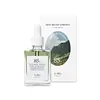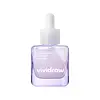What's inside
What's inside
 Key Ingredients
Key Ingredients

 Benefits
Benefits

 Concerns
Concerns

 Ingredients Side-by-side
Ingredients Side-by-side

Centella Asiatica Extract
CleansingWater
Skin ConditioningDipropylene Glycol
HumectantButylene Glycol
HumectantGlycerin
HumectantBenzyl Glycol
SolventAmmonium Acryloyldimethyltaurate/Vp Copolymer
Ethylhexylglycerin
Skin ConditioningPropanediol
SolventSodium Hyaluronate
HumectantPolyglyceryl-10 Laurate
Skin ConditioningPanthenol
Skin ConditioningCarbomer
Emulsion StabilisingAdansonia Digitata Fruit Extract
EmollientArginine
MaskingDipotassium Glycyrrhizate
HumectantCarthamus Tinctorius Flower Extract
Skin ConditioningLeontopodium Alpinum Callus Culture Extract
AntioxidantDisodium EDTA
Glyceryl Acrylate/Acrylic Acid Copolymer
Humectant1,2-Hexanediol
Skin ConditioningGardenia Florida Fruit Extract
Skin ConditioningDextrin
AbsorbentSqualane
EmollientCitrus Aurantium Bergamia Fruit Oil
MaskingAnastatica Hierochuntica Extract
AstringentChamomilla Recutita Flower/Leaf/Stem Extract
Skin ConditioningCorn Starch Modified
AbsorbentPeat Water
Skin ConditioningHydrolyzed Glycosaminoglycans
HumectantAcetic Acid
BufferingCaprylic/Capric Triglyceride
MaskingCitric Acid
BufferingSpirulina Maxima Extract
SmoothingSodium Hyaluronate Crosspolymer
HumectantHydrolyzed Hyaluronic Acid
HumectantHydrogenated Lecithin
EmulsifyingHydroxypropyltrimonium Hyaluronate
Ceramide NP
Skin ConditioningHyaluronic Acid
HumectantSodium Acetylated Hyaluronate
HumectantLimonene
PerfumingLinalool
PerfumingCentella Asiatica Extract, Water, Dipropylene Glycol, Butylene Glycol, Glycerin, Benzyl Glycol, Ammonium Acryloyldimethyltaurate/Vp Copolymer, Ethylhexylglycerin, Propanediol, Sodium Hyaluronate, Polyglyceryl-10 Laurate, Panthenol, Carbomer, Adansonia Digitata Fruit Extract, Arginine, Dipotassium Glycyrrhizate, Carthamus Tinctorius Flower Extract, Leontopodium Alpinum Callus Culture Extract, Disodium EDTA, Glyceryl Acrylate/Acrylic Acid Copolymer, 1,2-Hexanediol, Gardenia Florida Fruit Extract, Dextrin, Squalane, Citrus Aurantium Bergamia Fruit Oil, Anastatica Hierochuntica Extract, Chamomilla Recutita Flower/Leaf/Stem Extract, Corn Starch Modified, Peat Water, Hydrolyzed Glycosaminoglycans, Acetic Acid, Caprylic/Capric Triglyceride, Citric Acid, Spirulina Maxima Extract, Sodium Hyaluronate Crosspolymer, Hydrolyzed Hyaluronic Acid, Hydrogenated Lecithin, Hydroxypropyltrimonium Hyaluronate, Ceramide NP, Hyaluronic Acid, Sodium Acetylated Hyaluronate, Limonene, Linalool
Water
Skin ConditioningPropanediol
SolventMethylpropanediol
SolventNiacinamide
SmoothingButylene Glycol
HumectantAllium Cepa Bulb Extract
Skin ConditioningAllium Cepa Skin Extract
Humectant1,2-Hexanediol
Skin ConditioningBetaine
HumectantGlyceryl Polymethacrylate
Glycerin
HumectantPentylene Glycol
Skin ConditioningChondrus Crispus Extract
Skin ConditioningAcrylates/C10-30 Alkyl Acrylate Crosspolymer
Emulsion StabilisingChlorella Vulgaris Extract
Skin ConditioningGlucose
HumectantSaccharum Officinarum Extract
MoisturisingAmmonium Acryloyldimethyltaurate/Vp Copolymer
Tromethamine
BufferingPanthenol
Skin ConditioningAllantoin
Skin ConditioningAlpha-Arbutin
AntioxidantFructooligosaccharides
HumectantFructose
HumectantCellulose Gum
Emulsion StabilisingMadecassoside
AntioxidantEthylhexylglycerin
Skin ConditioningLimnanthes Alba Seed Oil
Skin ConditioningMacadamia Ternifolia Seed Oil
EmollientSqualane
EmollientSuccinic Acid
BufferingHydrogenated Lecithin
EmulsifyingHydrogenated Polydecene
EmollientTriisostearin
Skin ConditioningXanthan Gum
EmulsifyingButyrospermum Parkii Butter
Skin ConditioningMalachite Extract
AntioxidantCeramide NP
Skin ConditioningPolyglyceryl-10 Laurate
Skin ConditioningPolyglyceryl-3 Methylglucose Distearate
EmulsifyingAsiaticoside
AntioxidantCentella Asiatica Leaf Extract
Skin ConditioningCyanocobalamin
Skin ConditioningSodium Ascorbyl Phosphate
AntioxidantTocopherol
AntioxidantMagnesium Ascorbyl Phosphate
AntioxidantMaltodextrin
AbsorbentLecithin
EmollientWater, Propanediol, Methylpropanediol, Niacinamide, Butylene Glycol, Allium Cepa Bulb Extract, Allium Cepa Skin Extract, 1,2-Hexanediol, Betaine, Glyceryl Polymethacrylate, Glycerin, Pentylene Glycol, Chondrus Crispus Extract, Acrylates/C10-30 Alkyl Acrylate Crosspolymer, Chlorella Vulgaris Extract, Glucose, Saccharum Officinarum Extract, Ammonium Acryloyldimethyltaurate/Vp Copolymer, Tromethamine, Panthenol, Allantoin, Alpha-Arbutin, Fructooligosaccharides, Fructose, Cellulose Gum, Madecassoside, Ethylhexylglycerin, Limnanthes Alba Seed Oil, Macadamia Ternifolia Seed Oil, Squalane, Succinic Acid, Hydrogenated Lecithin, Hydrogenated Polydecene, Triisostearin, Xanthan Gum, Butyrospermum Parkii Butter, Malachite Extract, Ceramide NP, Polyglyceryl-10 Laurate, Polyglyceryl-3 Methylglucose Distearate, Asiaticoside, Centella Asiatica Leaf Extract, Cyanocobalamin, Sodium Ascorbyl Phosphate, Tocopherol, Magnesium Ascorbyl Phosphate, Maltodextrin, Lecithin
Ingredients Explained
These ingredients are found in both products.
Ingredients higher up in an ingredient list are typically present in a larger amount.
1,2-Hexanediol is a synthetic liquid and another multi-functional powerhouse.
It is a:
- Humectant, drawing moisture into the skin
- Emollient, helping to soften skin
- Solvent, dispersing and stabilizing formulas
- Preservative booster, enhancing the antimicrobial activity of other preservatives
Ammonium Acryloyldimethyltaurate/Vp Copolymer (let's call it AAVC for short) is a synthetically created polymer. It's used as a film-forming agent and used to thicken the consistency of products.
AAVC is able to increase the consistency and viscosity of products due to its large molecule size. It also prevents ingredients from separating.
Butylene Glycol (or BG) is used within cosmetic products for a few different reasons:
Overall, Butylene Glycol is a safe and well-rounded ingredient that works well with other ingredients.
Though this ingredient works well with most skin types, some people with sensitive skin may experience a reaction such as allergic rashes, closed comedones, or itchiness.
Learn more about Butylene GlycolCeramide NP is a type of ceramide and formally known as ceramide 3.
Ceramides are intercellular lipids naturally found in our skin that bonds dead skin cells together to create a barrier. They are known for their ability to hold water and thus are a great ingredient for dry skin.
Ceramides are an important building block for our skin barrier. A stronger barrier helps the skin look more firm and hydrated. By bolstering the skin ceramides act as a barrier against irritating ingredients. This can help with inflammation as well.
If you would like to eat ceramides, sweet potatoes contain a small amount.
Read more about other common types of ceramides here:
Ceramide AP
Ceramide EOP
Ethylhexylglycerin (we can't pronounce this either) is commonly used as a preservative and skin softener. It is derived from glyceryl.
You might see Ethylhexylglycerin often paired with other preservatives such as phenoxyethanol. Ethylhexylglycerin has been found to increase the effectiveness of these other preservatives.
Glycerin is already naturally found in your skin. It helps moisturize and protect your skin.
A study from 2016 found glycerin to be more effective as a humectant than AHAs and hyaluronic acid.
As a humectant, it helps the skin stay hydrated by pulling moisture to your skin. The low molecular weight of glycerin allows it to pull moisture into the deeper layers of your skin.
Hydrated skin improves your skin barrier; Your skin barrier helps protect against irritants and bacteria.
Glycerin has also been found to have antimicrobial and antiviral properties. Due to these properties, glycerin is often used in wound and burn treatments.
In cosmetics, glycerin is usually derived from plants such as soybean or palm. However, it can also be sourced from animals, such as tallow or animal fat.
This ingredient is organic, colorless, odorless, and non-toxic.
Glycerin is the name for this ingredient in American English. British English uses Glycerol/Glycerine.
Learn more about GlycerinHydrogenated Lecithin is created from the hydrogenation of lecithin (a group of phospholipids). Hydrogenation is a chemical reaction between hydrogen and another element.
This ingredient is an emollient and emulsifier. As an emollient, it helps soften skin by trapping moisture within. As an emulsifier, it prevents oil and water ingredients from separating.
Panthenol is a common ingredient that helps hydrate and soothe the skin. It is found naturally in our skin and hair.
There are two forms of panthenol: D and L.
D-panthenol is also known as dexpanthenol. Most cosmetics use dexpanthenol or a mixture of D and L-panthenol.
Panthenol is famous due to its ability to go deeper into the skin's layers. Using this ingredient has numerous pros (and no cons):
Like hyaluronic acid, panthenol is a humectant. Humectants are able to bind and hold large amounts of water to keep skin hydrated.
This ingredient works well for wound healing. It works by increasing tissue in the wound and helps close open wounds.
Once oxidized, panthenol converts to pantothenic acid. Panthothenic acid is found in all living cells.
This ingredient is also referred to as pro-vitamin B5.
Learn more about PanthenolPolyglyceryl-10 Laurate is an ester of lauric acid and Polyglycerin-10.
Polyglyceryl-10 Laurate is a cleansing agent and emulsifier. It helps gather dirt, oil, and other pollutants to be rinsed away. As an emulsifier, it helps prevent ingredients from separating, such as oil and water.
Polyglyceryl-10 Laurate may not be fungal acne safe.
Learn more about Polyglyceryl-10 LauratePropanediol is an all-star ingredient. It softens, hydrates, and smooths the skin.
It’s often used to:
Propanediol is not likely to cause sensitivity and considered safe to use. It is derived from corn or petroleum with a clear color and no scent.
Learn more about PropanediolSqualane is an emollient that helps the skin hold onto moisture. It's an oily liquid that occurs naturally in certain types of fish and plant oils.
Because squalane boosts hydration in the skin, it also comes with plenty of benefits: it is an antioxidant and can help fight free radicals and skin damage. Squalane is also found to have a detoxifying effect when applied.
Squalane comes from squalene, which occurs naturally within the sebum of our skin. It is one of the oils our skin produces to keep itself hydrated. Squalane is the hydrogenated version of squalene and has a longer shelf life.
Research shows that squalane is non-irritating (even at 100% concentration).
In general, it's a fantastic ingredient. It does a great job at hydrating the skin, and it's suitable for those with sensitive skin.
The source of squalane may impact malassezia / fungal acne. This is because olive oil derived squalane can contain impurities such as fatty acids and plant waxes. Sugarcane derived squalane is recommended for anyone with malassezia concerns.
Is squalane vegan?
This depends on the source. Squalane can be derived from both plants and animals. Most squalane used in skincare comes from plants.
Please note: the source of squalane is only known if disclosed by the brand. We recommend reaching out to the brand if you have any questions about their squalane.
Read more about squalene with an "e".
Is squalane an oil?
Squalane is often called an oil, but it’s technically not; it’s a hydrocarbon, meaning it’s only made of carbon and hydrogen, unlike true oils which are triglycerides made of fatty acids and glycerol.
The term “oil-free” isn’t regulated, so companies can define it however they want. Some exclude all oils, while others just avoid mineral oil or comedogenic oils.
While some people avoid oils thinking they cause breakouts, the right kind of oil (or oil-like ingredient like squalane) can actually help balance and hydrate your skin. It’s worth testing out simple oils or squalane to see what works best for your skin.
Learn more about SqualaneWater. It's the most common cosmetic ingredient of all. You'll usually see it at the top of ingredient lists, meaning that it makes up the largest part of the product.
So why is it so popular? Water most often acts as a solvent - this means that it helps dissolve other ingredients into the formulation.
You'll also recognize water as that liquid we all need to stay alive. If you see this, drink a glass of water. Stay hydrated!
Learn more about Water